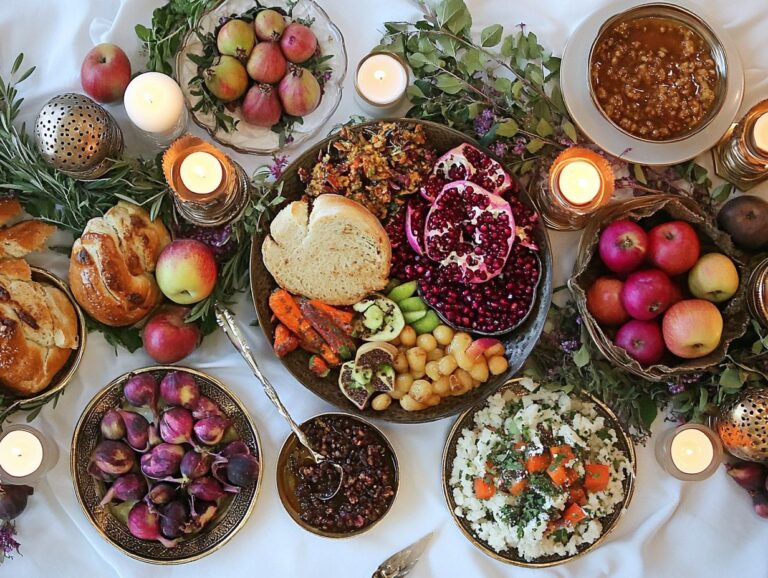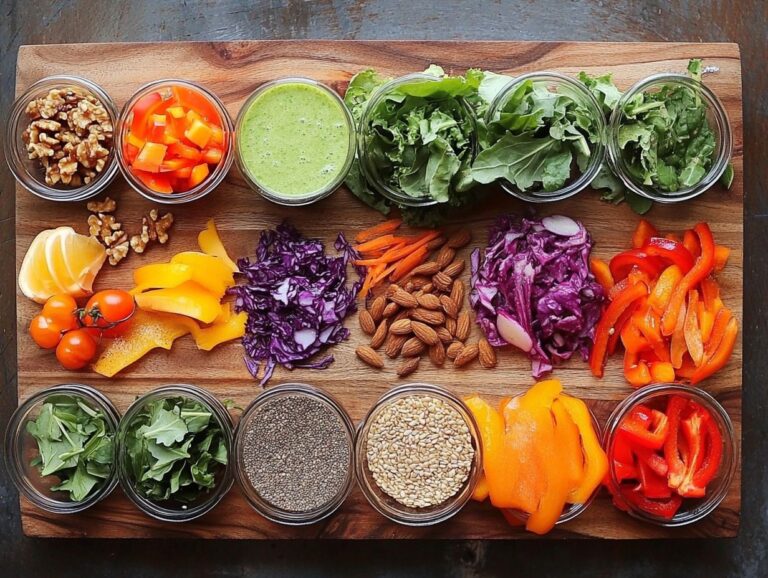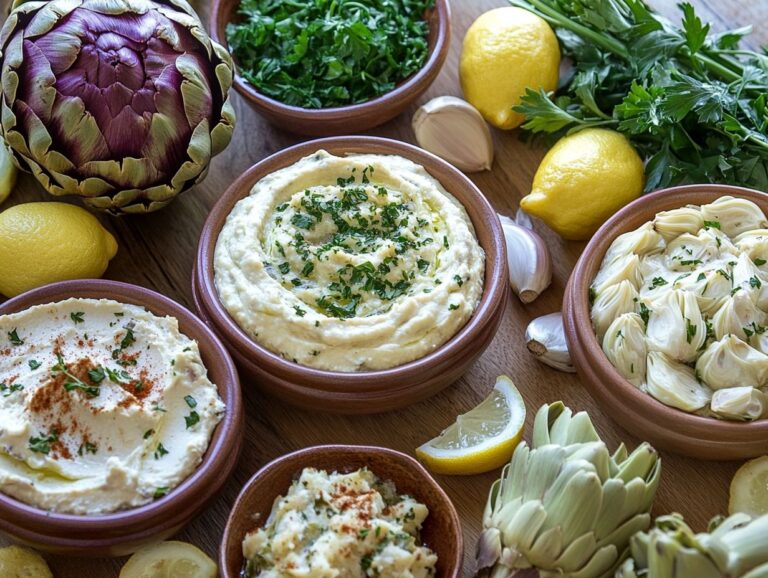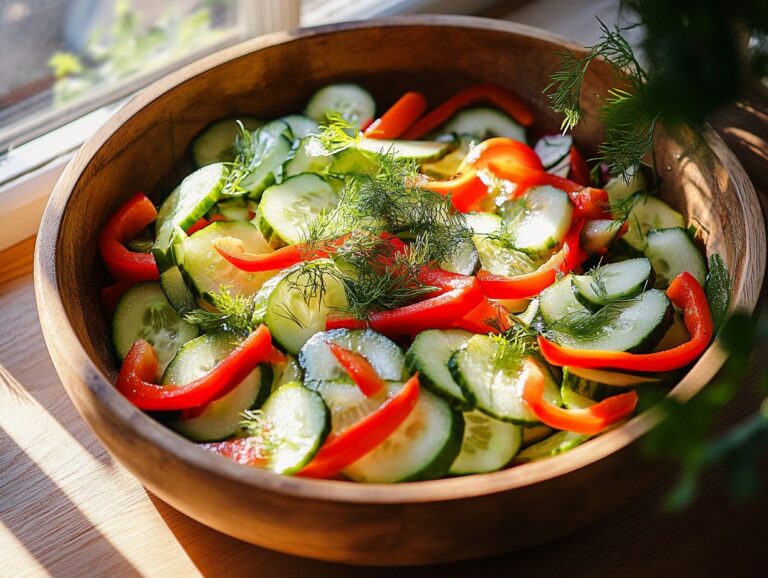Mung beans are an essential ingredient that every vegan kitchen should include due to their versatility and high protein content. They are rich in protein and other vital nutrients, making them a versatile foundation for many satisfying and wholesome recipes. This article explores the impressive nutritional profile of mung beans and provides a variety of simple and delicious vegan recipes, including curries, salads, soups, and stir-fry dishes. Additionally, it offers cooking tips for those following a gluten-free diet, creative ideas for incorporating mung beans as a staple ingredient, and emphasizes their role in sustainable and vegan cooking. Get inspired by the culinary creativity that mung beans can bring to your kitchen!
Why Mung Beans are a Great Addition to Vegan Diets

Mung beans are an essential ingredient in vegan diets, serving as an excellent source of plant protein and offering a wide range of additional nutrients, making them a key component in various plant-based meals. This makes them a staple food for individuals pursuing a healthy, plant-based lifestyle and looking for nutrient-dense, guilt-free options.
They are high in fiber, possess a well-balanced amino acid profile, and are rich in essential micronutrients, including vitamins B, C, and K, as well as folic acid, potassium, calcium, magnesium, iron, manganese, copper, phosphorus, and zinc. This diverse nutritional profile is a hallmark of sustainable diets. Incorporating mung beans into your meals can enhance both the flavor and nutritional value of your dishes, making them ideal for everyday meals and gourmet cooking alike.
Benefits of a Mung Bean Diet
Mung beans are low in calories while being rich in nutrients, making them an excellent choice for those looking to lose weight or to consume more nutrients per calorie, perfect for those seeking healthy, balanced meals. Additionally, they are high in antioxidants, which can help reduce oxidative stress and inflammation, potentially lowering the risk of chronic diseases and promoting overall wellness.
Mung beans can also be easily sprouted, which increases the availability of vitamins and enzymes, adding a delightful crunch to salads, sandwiches, and other fresh ingredients-based dishes. As nitrogen-fixing plants, they reduce the need for synthetic fertilizers, aligning with the principles of sustainable agriculture, eco-friendly practices, and the fundamental ethical values of vegan cooking.
Mung Bean Nutrition and Benefits
Mung beans are highly nutritious and offer numerous health benefits, making them an excellent food choice for individuals following a vegan or vegetarian diet, or those looking for high-protein, nutrient-dense options.
They are rich in protein, serving as a valuable protein source for plant-based diets. Additionally, mung beans provide a good amount of dietary fiber, which is essential for healthy digestion and can help maintain stable blood sugar levels.
Furthermore, they are packed with essential nutrients, including vitamins, minerals, and antioxidants.
Protein Content and Other Nutrients
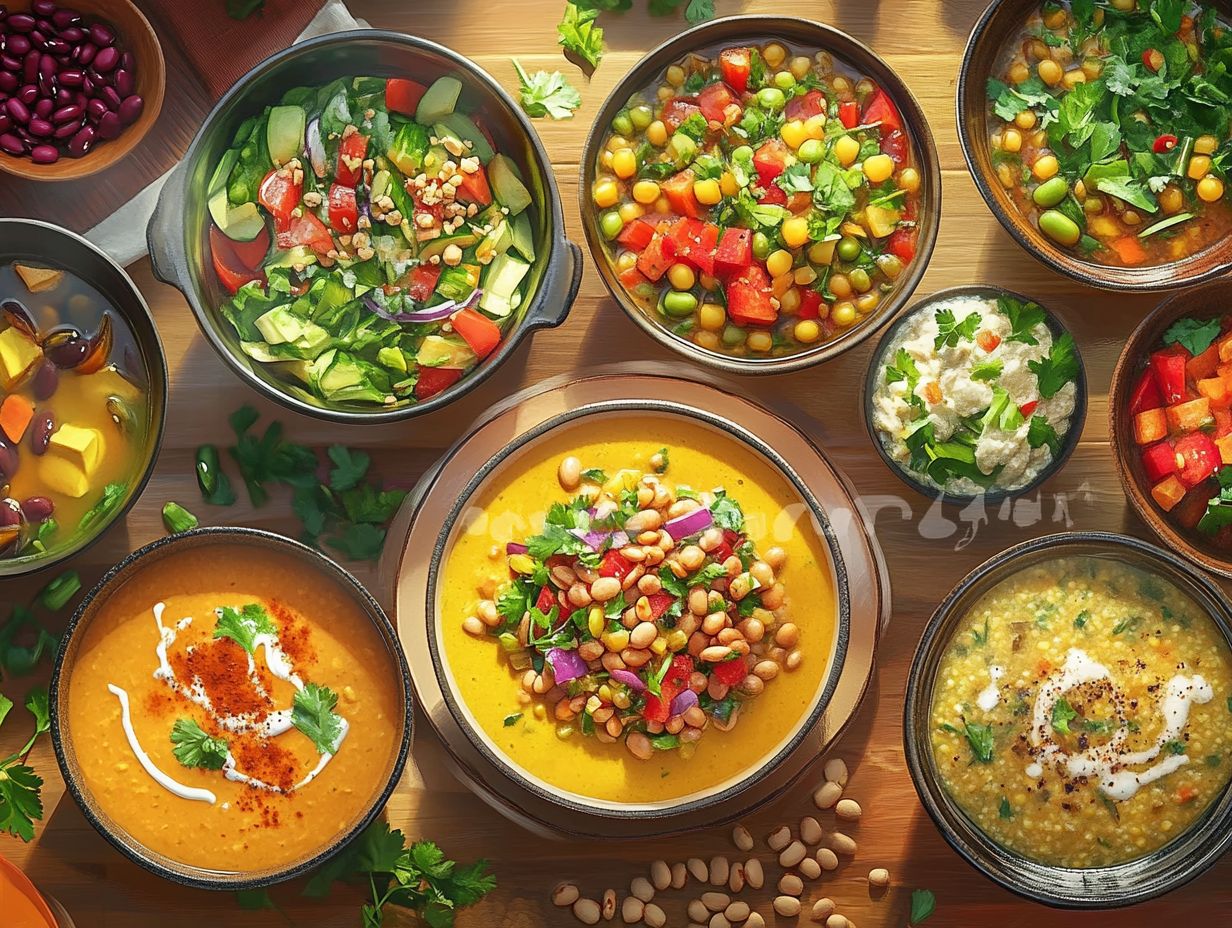
Mung beans provide 14 grams of protein per cooked cup, making them an excellent source of plant-based protein for vegans and those seeking protein alternatives. They are also rich in dietary fiber, amino acids, and various vitamins and minerals, enhancing their overall nutritional value and contributing to sustainable eating habits.
For instance, the amino acids found in mung beans, such as leucine, lysine, and valine, play a crucial role in muscle repair and growth. When compared to other plant-based protein sources, mung beans are particularly comparable to animal proteins due to their complete amino acid profile.
Their high fiber content aids digestion and helps maintain stable blood sugar levels, which complements the nutritional benefits offered by their vitamins, including vitamin B6, iron, and magnesium, supporting overall energy levels and vitality.
Overall, mung beans are a balanced option for meeting protein and nutritional needs, especially within diverse diets, and can be easily incorporated into wholesome recipes and quick dishes.
Easy Vegan Mung Bean Recipes
Easy vegan mung bean recipes are an excellent way to incorporate this healthy legume into your daily meals, offering a variety of delicious flavors and textures suitable for family-friendly and everyday meals.
From savory curries and soups to light salads and spreads, mung beans can be used to create a wide array of tasty, protein-rich dishes suitable for the entire family, making meal diversity and vegan meal ideas simple and enjoyable.
These plant-based meals not only provide essential nutrients but also cater to various dietary preferences and cooking methods, making it easier for people to maintain a healthy diet and a vegan lifestyle.
Mung Bean Curry

Mung bean curry is a delicious and nutritious dish that highlights the versatility of mung beans, making it an excellent choice for any vegan diet and a flavorful addition to your culinary repertoire. This simple recipe combines mung beans with spices, herbs, and vegetables, resulting in a flavor profile that is often savory and occasionally sweet.
It can be prepared to a thick or thin consistency, making it suitable for both family meals and special occasions, and an ideal comfort food. Mung bean curry is easy to make and offers numerous health benefits, making it a staple in plant-based diets and a perfect option for batch cooking.
Key ingredients such as cumin, turmeric, coriander, and cayenne enhance the flavor, while fresh herbs like cilantro and curry leaves contribute authenticity, creating rich flavor combinations.
To prepare this wholesome curry, start by soaking the mung beans to ensure they cook to the desired consistency. Begin by sautéing onions, garlic, and ginger before adding the spices. Then, incorporate the mung beans along with coconut milk or vegetable broth for a creamy texture.
Variations can include seasonal vegetables such as spinach or tomatoes, which boost the nutritional value of the dish. Serving the curry over steamed rice or alongside warm naan enhances the overall experience.
This dish allows for easy experimentation with spices, enabling you to tailor it to your individual taste preferences and create unique, protein-packed dishes.
Mung Bean Salad
A mung bean salad is a refreshing and nutritious way to enjoy the health benefits of this legume, perfect for meal prep and offering diverse flavors. It combines fresh produce with protein-packed mung beans to create a vibrant dish. This easy recipe is perfect for meal prep or as a side dish for gatherings, offering a colorful presentation and a delightful flavor profile, making it a staple in easy-to-make, nutrient-dense meals. The mung bean salad not only showcases the versatility of legumes but also provides a wholesome option for anyone pursuing a healthy, plant-based lifestyle and looking for simple, guilt-free dishes.
The base of this salad emphasizes the delightful simplicity of wholesome ingredients that work harmoniously together. To prepare this dish, you’ll need:
- Cooked and cooled mung beans
- Diced cucumbers
- Cherry tomatoes
- Bell peppers
- Finely chopped red onions
Fresh herbs like parsley or cilantro can elevate the taste, adding a burst of flavor and freshness, contributing to the overall vegan nutrition of the salad. For the dressing, a zesty blend of olive oil, lemon juice, salt, and pepper makes an invigorating addition.
Nutritionally, this salad is rich in protein, fiber, and essential vitamins, while mung beans can help regulate blood sugar levels. For those looking to switch things up, feel free to incorporate avocado, feta cheese, or other seasonal vegetables to customize your experience, enhancing the nutrient-dense and culinary appeal of the salad.
Mung Bean Soup
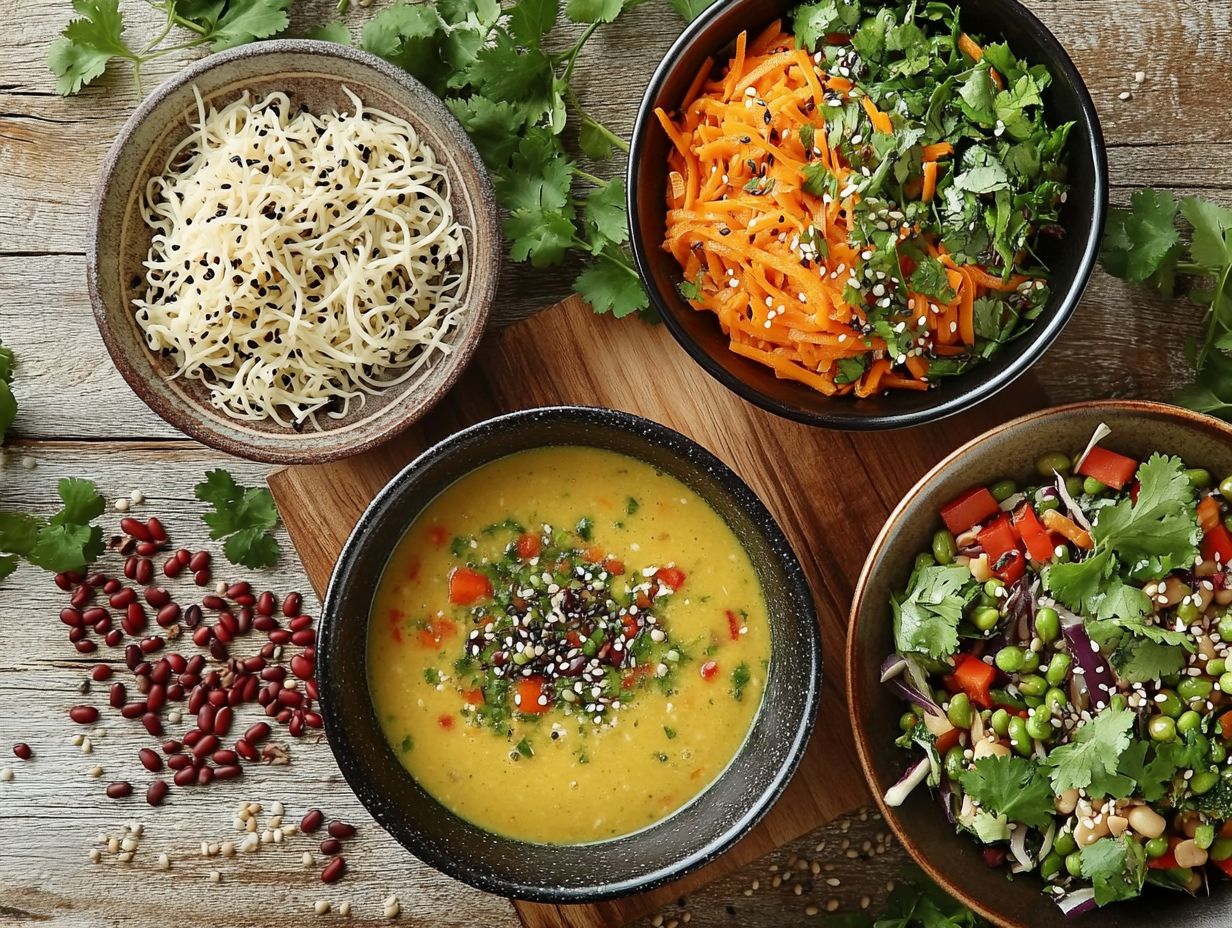
Mung bean soup is a healthy and comforting meal that is easy to prepare, making it perfect for family gatherings and a classic example of hearty, wholesome recipes. This hearty vegan recipe features mung beans, seasonal produce, and spices, resulting in a soup that is both delicious and nutrient-rich, ideal for those following a vegetarian or vegan diet.
Packed with protein and dietary fiber, mung bean soup is suitable for any time of the year and is ideal for those following a healthy vegan lifestyle, providing comfort food that is both nutritious and satisfying.
The process begins by soaking the mung beans, which makes them easier to digest and speeds up cooking time. After soaking, the beans are boiled and simmered with ingredients such as carrots, onions, and garlic, creating a stew-like consistency that offers a satisfying sweetness and depth of flavor.
The addition of spices like cumin and turmeric enhances the taste while providing anti-inflammatory benefits, resulting in a delightful combination of creamy, tender beans and crunchy vegetables in each bite, making it a standout in vegan cooking.
To finish, topping the soup with fresh cilantro or a squeeze of lime juice adds extra layers of flavor and freshness to the dish.
Mung Bean Recipes for Specific Dietary Needs
Mung bean recipes are versatile and can be adapted to meet various dietary needs, making them an essential component of any cuisine and an affordable meal option.
Whether you’re looking for gluten-free options or flavorful vegan meals, mung beans can be transformed into delicious dishes that cater to specific dietary restrictions, promoting sustainable eating and meal diversity.
These recipes not only offer essential nutrients but also ensure that healthy eating remains accessible and enjoyable for everyone, supporting the vegan lifestyle with easy recipes and creative cooking ideas.
Gluten-Free and Dairy-Free Options
Mung beans are versatile ingredients that are particularly popular in gluten- and dairy-free cooking, as well as within a healthy, plant-based lifestyle, encompassing a wide range of vegan meal ideas. Here are some popular uses for mung beans in cooking:
- Mung Bean Soups: Mung beans can be cooked in vegetable broth or water to create a simple soup. For a creamier texture, coconut milk can be added, serving as an excellent substitute for cream in gluten- and dairy-free recipes, creating guilt-free, comforting dishes.
- Mung Bean Curries: Mung beans can be incorporated into vegetable curries, with spices such as turmeric, cumin, and coriander added for enhanced flavor.
- Mung Bean Salads: Sprouted mung beans can be added to salads, boosting their nutritional profile and adding a refreshing crunch.
- Mung Bean Stews: Mung beans can be used in stews, either on their own or as a protein supplement in various vegetable-based recipes, making them a versatile ingredient in hearty, nutrient-dense meals.
- Mung Bean Snacks: Roasted mung beans can be seasoned with spices like chili powder and salt, creating a nutritious snack option that is perfect for quick dishes.
- Mung Bean Dips: Cooked and blended mung beans can be incorporated into dips and spreads such as hummus, guacamole, or salsa, enhancing the protein and fiber content of these meals, and serving as delicious vegan protein options.
- Mung Bean Sandwich Fillings: Mung beans can be added to vegetable sandwich fillings, elevating the nutritional value of the dish and making it a balanced meal option.
Overall, mung beans are not only nutritious on their own but also serve as a valuable ingredient to enhance the nutritional value of various meals.
Tips for Cooking with Mung Beans
Mung beans are a versatile and easy-to-cook legume, perfect for crafting easy recipes. They can be used to create a variety of simple dishes that cater to different preferences and dietary restrictions, offering high protein and nutrients.
Various culinary techniques and preparation methods can enhance the flavor and nutritional value of mung beans, making them ideal for vegan diets. Additionally, kitchen hacks and tips for cooking with mung beans can elevate dishes and enrich plant-based cooking, suitable for everyday meals and sustainable eating.
Preparation and Cooking Techniques: High Protein and Fiber Meals
To achieve the best flavor and digestibility, mung beans must be properly prepared and cooked. Start by rinsing and soaking the mung beans in water for several hours. This process not only reduces cooking time but also enhances the taste and texture of the beans, making them a perfect protein source for vegan meal ideas.
After soaking, the mung beans can be simmered and added to various dishes like curries or cooked in a pressure cooker for nutritious and delicious meals. For optimal results, soak the beans for approximately 4-6 hours to soften them and improve their nutritional benefits, providing essential nutrients for a vegan lifestyle.
Following this, simmer the beans in water for 20-30 minutes, or use a pressure cooker, which shortens the cooking time to about 5-10 minutes. Once cooked, they can be incorporated into hearty mung bean soups, fresh salads, or serve as a protein-rich addition to stir-fries, providing a wholesome and savory touch to diverse flavors.
Be sure to season them well with herbs and spices after cooking for enhanced flavor, infusing them with gourmet taste and balancing them with fresh ingredients for creative cooking.
